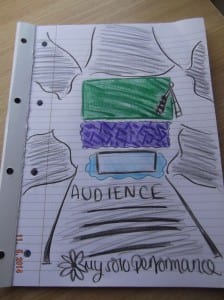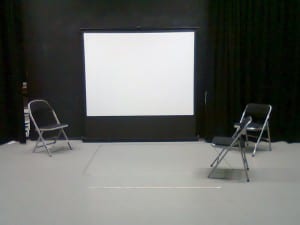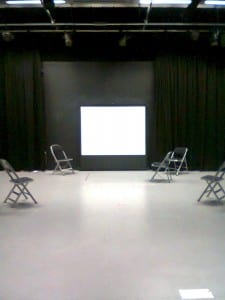February22
Over the past few weeks, as we’ve been researching different solo artists within the field, many ideas have started to occur in terms of the potential and the possibilities with what I can do with my own solo performance.
I’m taken by the idea of being theatrical, to make the audience aware of the fact that my performance is a performance that was an idea enhanced through researching solo performer David Cale:
*As a solo performer he is known as a storytelling monologist and refers to his work as being ‘theatrical’ (Churnin, 1990) so much so that it’s almost like you’re in a novel.
*Through his poetic storytelling technique, powerful imagery is evoked. He achieves this by the idealism/hope/optimism/romanticism he creates in his work which is almost fairytale like. For instance The History of Kisses, 2011, is a fictional monologue ‘about a writer who’s trying to finish a collection of stories that all take place by the sea and they’re all romantic’ (Kansas City Repertory Theatre Company, 2011).
*His way of working is to write stories, characters, monologues and words that fit with music and then put them all together. With his show Palomino, 2009, he says the music is scored ‘like a film’, but dressed very simply as it’s all about the performance’ (Center Theatre Group, 2010).
The theatre is generally regarded as a place and space of escapism from the ordinariness of everyday life. Focusing on this will enable me to play with these notions of illusion and reality, between what is happening and what could happen for instance.
“To blur everyday life with the fictional realm of performance” (Govan et al, 2007, 21)
In blurring this distinction, it would also allow me to experiment with the performing of the subconscious in opposition to what is conscious. This would provide the connection between the real and the imagined in terms of the pictures and images created from the language spoken. In revealing the unruly, the subconscious, “the imaginary distance between performer and the work performed” (Howell, 1979, 154) would be enhanced and I would aim to exploit this connection further through experimentation with lights, sound, tone and atmosphere.
“Where her words rather than her body dominate the production…the use of the text as a stream of consciousness is meant to stand for consciousness” (Carroll, 1979, 54-55)
Grappling with all of these ideas will also allow me to create a piece, not wholly autobiographically, but one that contains within it elements of my personal imagination.
To be true to myself.
The “presentation of self and role…encounter with one’s own sense of self” (Giannachi et al, 2012, 2)
In terms of creating a performance that combines all of the elements I have been deliberating over, I’m keen to base the concept of my performance around the idea of the acting industry. Being in my 3rd year, I am at a time in my life where I am considering many career options and in studying Drama, acting is potentially a possibility.
TeCHniQUeS
Headphones – to divide, not only the audience in terms of them hearing what is being seen as separated pieces of the performance – joining the two together to create personal meaning, – but to play with the idea and distort the notion between what is fact and what is fiction. I would also encourage this ambiguity by having a narrative that only alluded to the concept of the story.
“To contrast an invisible living, “inner” voice with its visible, “outer” manifestation” (Carroll, 1979, 56)
I could enhance the use of the headphones by having the audience switch between the two different worlds, zoning in and out of each as they wish. In this transaction what they would establish and gain from both worlds, in terms of the meaning created, would be that of a journey with each audience member feeling and imagining, through the narrative, something different, something personal to them as to what that journey stands for in their own lives.
“Jacques Derrida described as ‘a discourse on the frame’ that places meaning on works of art and invites spectators to question the limits of art and non-art” (Govan et al, 2007, 21).
References:
Carroll, N. (1979) Amy Taubin: The Solo Self. The Drama Review, 23 (1) 51-58.
Center Theatre Group (2010) An Interview with David Cale. [online video] Available from: http://www.youtube.com/watch?v=B0x-P4MtfEg [Accessed 2 February 2014].
Churnin, N. (1990) Stage Review: One Man’s “Little Stories” Deliver Large Dose of Truth: David Cale Takes your Breath Away on an Unforgettable Tour Through the World of Lost Souls. [online] Los Angeles: Los Angels Times. Available from: http://articles.latimes.com/1990-01-06/entertainment/ca-391_1_david-cale [Accessed 1 February 2014].
Giannachi, G., Kaye, N. and Shanks, M. (2012) Archaeologies of Presence. London and New York: Routledge.
Govan, E. Nicholson, H. and K. Normington (2007) Making a Performance: Devising Histories and Contemporary Practices. Oxon: Routledge.
Howell, J. (1979) Solo in Soho: The Performer Alone. Performing Arts Journal, 14 (1/2) 152-158.
Kansas City Repertory Theatre Company (2011) David Cale on ‘The History of Kisses’. [online video] Available from: http://www.youtube.com/watch?v=Rp5lPXb_Log [Accessed 25 January 2014].



![Stirling, L. (2012) Shadows. Available from: http://www.youtube.com/watch?v=JGCsyshUU-A [Accessed 22 February 2014].](https://soloperformancenichollsn.blogs.lincoln.ac.uk/files/2014/03/Shadows-300x168.jpg)
![Stirling, L. (2013) Lord of the Rings. Available from: http://www.fanpop.com/clubs/music/images/33546505/title/lindsey-stirling-photo [Accessed 3 March 2014].](https://soloperformancenichollsn.blogs.lincoln.ac.uk/files/2014/03/LSLOTR-300x163.png)
![Stirling, L. (2012) Song of the Caged Bird. Available from: http://lindseystirling.ca/videos/page/3/ [Accessed 3 March 2014].](https://soloperformancenichollsn.blogs.lincoln.ac.uk/files/2014/03/Song_of_the_Caged_Bird-300x168.jpg)
Recent Comments